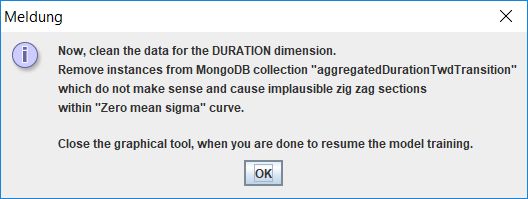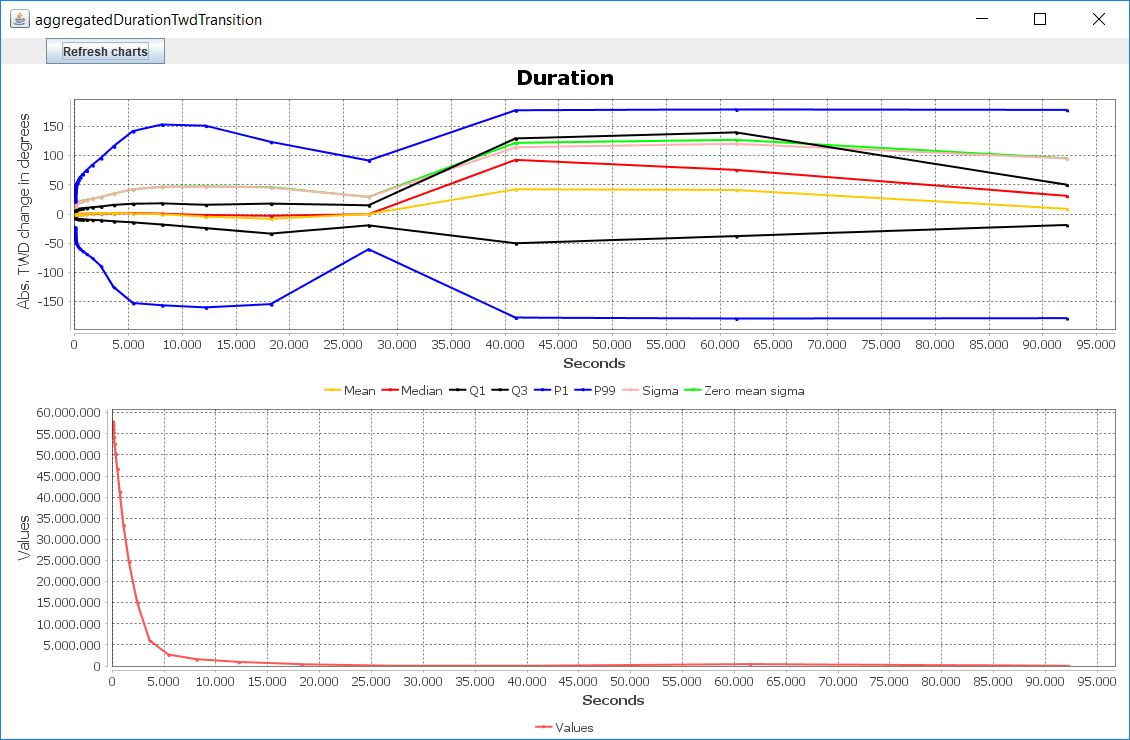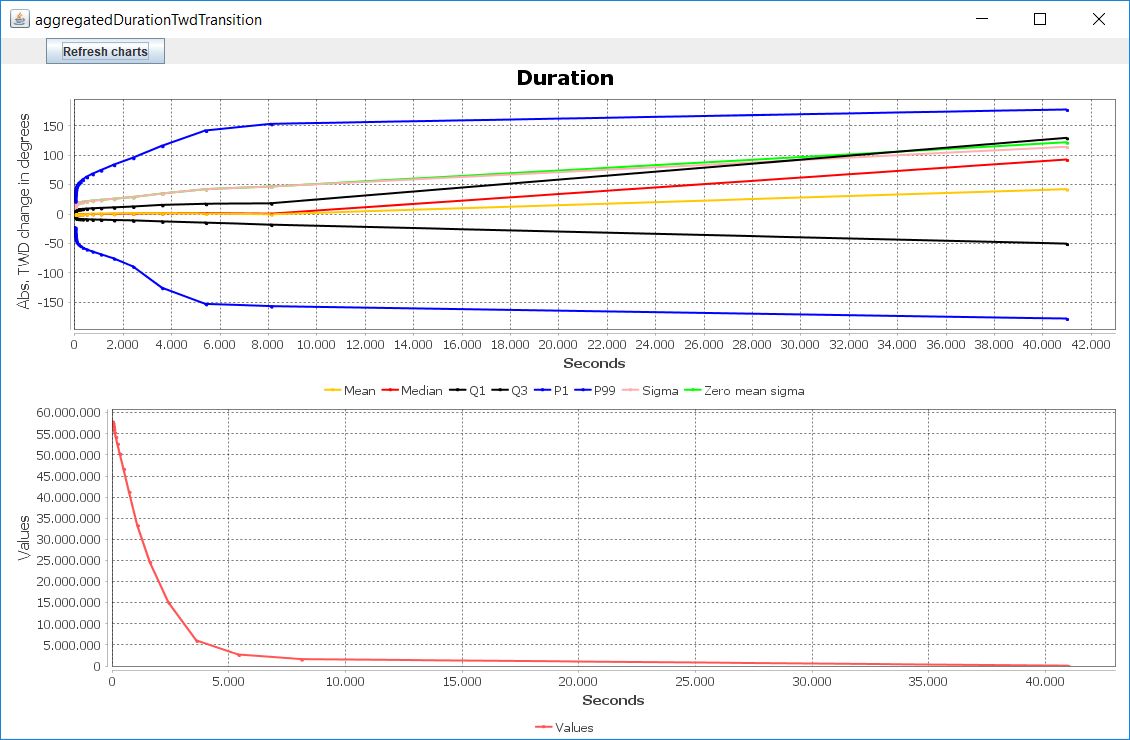Training of internal Wind Estimation models
This document describes the generation process of Machine Learning (ML) models which are used internally by the maneuver-based wind estimation. It is highly recommended to process this howto step by step considering the order of sections. At the end of this howto, you will generate a file containing the representation of internal models used by com.sap.sailing.windestimation bundle. You can use this file to update the wind estimation models of a running server instance. If you are interested in a more advanced tutorial which requires all the execution steps contained in SimpleModelsTrainingPart... classes to be executed manually, then you might be interested in Advanced Guide for training of internal Wind Estimation models
Prerequisites
To complete the training process successfully, you need to make sure that you have the following stuff:
- A complete onboarding setup for SAP Sailing Analytics development
- MongoDB (3.4 or higher!) is up and running (can be the same MongoDB instance as required in onboarding howto)
- At least 100 GB free space on the partition where MongoDB is operating in case you're using the WiredTiger storage engine (the default for MongoDB 3.4 and upwards), otherwise at least 300GB
- Installed graphical MongoDB client such as MongoDB Compass (Community version), or you're skilled with the
mongocommand line tool - 16 GB RAM
- 24+ operating hours of a computer that has a Java 8 VM installed
Model training process
Docker-Based
In our docker registry under docker.sapsailing.com there is a repository called windestimationtraining where images can be found to run the training process in a mostly automated way. All you need is an account for docker.sapsailing.com and an account on sapsailing.com that has the TRACKED_RACE:EXPORT permission for all races in the archive server (see the raw-data role). Furthermore, you need a MongoDB with approximately 100GB of available space. This can be a MongoDB replica set, of course. All you need is the URI to establish the connection.
If you want to try the following on a plain Amazon Linux instance, try to start with an instance type that has fast SSD storage attached (NVMe) and 16GB of RAM, such as c5d.2xlarge. SSH into it (probably with the ec2-user account), then try this:
sudo -i
# Launch cfdisk for the NVMe volume, give it a gpt partition table and create a single partition spanning the entire disk:
cfdisk /dev/nvme1n1
mkfs.xfs /dev/nvme1n1p1
mkdir /var/lib/mongo
mount /dev/nvme1n1p1 /var/lib/mongo
echo "[mongodb-org-4.4]
name=MongoDB Repository
baseurl=https://repo.mongodb.org/yum/amazon/2013.03/mongodb-org/4.4/x86_64/
gpgcheck=1
enabled=1
gpgkey=https://www.mongodb.org/static/pgp/server-4.4.asc" >/etc/yum.repos.d/mongodb-org-4.4.repo
yum update
yum install -y mongodb-org-server mongodb-org-tools mongodb-org-shell docker
chown mongod /var/lib/mongo
chgrp mongod /var/lib/mongo/etc/mongod.conf file in two places; one to restrict the cache size to limit MongoDB's memory use, and another one to expose MongoDB's default port 27017 also to the Docker network:
storage:
dbPath: /var/lib/mongo
journal:
enabled: true
+ wiredTiger:
+ engineConfig:
+ cacheSizeGB: 4
...
net:
port: 27017
- bindIp: 127.0.0.1
+ bindIp: "172.17.0.1,127.0.0.1"Then continue as follows:
systemctl start docker.service
systemctl start mongod
systemctl start docker
docker login docker.sapsailing.com
touch /tmp/windEstimationModels.datFor your account that is equipped with the TRACKED_RACE:EXPORT permission you'll need the bearer token which you can obtain, when logged in on the web site, from https://security-service.sapsailing.com/security/api/restsecurity/access_token. The value of the access_token attribute is what you will need in the following command:
docker run --mount type=bind,source=/tmp/windEstimationModels.dat,target=/home/sailing/windEstimationModels.dat \
-m 10g --rm -d \
-e MONGODB_URI="mongodb://172.17.0.1/windestimation?retryWrites=true" \
-e BEARER_TOKEN="{your-bearer-token-here}" \
-e MEMORY=-Xmx6g \
docker.sapsailing.com/windestimationtraining:latest--rm option otherwise to allow you to inspect logs after unsuccessful execution) you will find the output under /tmp/windEstimationModels.dat which you can upload as usual, e.g., as in
curl -X POST -H "Content-Type: application/octet-stream" --data-binary @windEstimationModels.dat \
-H "Authorization: Bearer 987235098w0t98yw409857098745=" \
https://host.sapsailing.com/windestimation/api/windestimation_dataCreating the Docker Image for Model Training
Under docker/Dockerfile_windestimation there is a docker file that can be used to produce the Docker image, given that a WindEstimationModelsTraining.jar exists under https://static.sapsailing.com/WindEstimationModelsTraining.jar. Producing an image works like this:
docker build --no-cache -f Dockerfile_windestimation -t docker.sapsailing.com/windestimationtraining:0.0.4 .To produce the JAR file used for the Docker image creation, run an "Export" command in Eclipse, using "File - Export - Runnable JAR File" with the SimpleModelsTrainingPart1 launch configuration. This will export a JAR that you can then upload to trac@sapsailing.com:static using a command such as
scp WindEstimationModelsTraining.jar trac@sapsailing.com:staticAI Core
In the "Canary - Public Cloud [Feature Set B]" landscape (Europe (Frankfurt) - Canary - AWS) we have a Global Account named "SAP Sailing Analytics" which is also used for our SAP Analytics Cloud (SAP) showcase. It is configured through the SAP BTP Control Center which can be reached at https://cp-control-client-uc2.cfapps.sap.hana.ondemand.com/index.html. There, in the Entitlements section you need the "AI Cockpit," "SAP AI Launchpad," and the "SAP AI Core" elements.
When managing this account in the SAP BTP Control Center (e.g., here) then under Entitlements these same services need to be present. In the "SAC Showcase" sub-account these entitlements then need to be configured. Afterwards, under "Instances and Subscriptions" the "SAP AI Core" and "SAP AI Launchpad" services can be subscribed to. Once the services are deployed, you'll see the "SAP AI Launchpad" subscription where you can use the "…" button to go to the application. This will take you to https://sac4sapsailing.ai-launchpad.prodintern.eu-central-1.aws.apps.ml.hana.ondemand.com/aic/index.html#/workspaces.
Obtain your API access key from the "Instances and Subscriptions" page from your "SAP AI Core" instance. See also https://help.sap.com/docs/AI_CORE/2d6c5984063c40a59eda62f4a9135bee/7323ff4e37ba41c198b06e9669b80920.html for a description. However, the way the descriptions there continues to explain how to set up the environment for API calls, e.g., with curl, didn't work for me. Instead, I started to create a bunch of scripts that help me with obtaining curl-based access, as well as establish the basic environment including Git repository access, access to a private Docker registry, an AWS S3 object store secret, a SAP Sailing Analytics bearer token secret, as well as the "Application" object that tells AI Core where to find workflow templates in the Git repository.
Create a service key using the "…" menu on your "SAP AI Core" instance and download the credentials file. This will can later be used as an argument to a little script aicore-credentials.sh that helps you set your shell variables for easy curl API access. Call like this:
eval `./aicore-credentials.sh YOUR-KEY-FILE.json`This will establish, in particular, a TOKEN and the AI_API_URL environment variable which can then be used by subsequent scripts and API calls which basically follow this pattern:
curl --location --request POST "$AI_API_URL/v2/admin/repositories" \
--header "Authorization: Bearer $TOKEN" \
--header 'Content-Type: application/json' \
...The next step is to establish a connection for the Docker registry from which Docker images are to be pulled. Log on to the registry you'd like to use, e.g., with a command such as
docker login docker.sapsailing.comThe credentials you provide are encoded in ~/.docker/config.json. You can then use the script configureDockerRegistry.sh to establish the image pull secret. Either provide the name of your docker registry (e.g., docker.sapsailing.com as the single argument to the script or call without argument to have the script prompt you for it. The script will then read your ~/.docker/config.json and extract the corresponding authorization information to pass it on as the AI Core registry secret.
Then, you can create the GIT connection. Use script createGitConfig.sh, either with three arguments (GIT URL, user email, personal access token (PAT)), or have the script prompt for these. I have created a Git repository with the necessary workflow definition under https://github.tools.sap/D043530/aicore-sailing. In the workflows folder there is a workflow-template.yaml file which contains the specification of an Argo workflow template. It runs the docker.sapsailing.com/windestimation:latest.
Traditional
- Run
com.sap.sailing.windestimation.model.SimpleModelsTrainingPart1as a normal Java Application. If you would like to run this outside of your development environment, use "Export as…" in Eclipse, pick the launch configuration forSimpleModelsTrainingPart1and let the exporter pack all required dependencies into the single executable JAR file that you can send anywhere you would like to execute it and then runjava -jar SimpleModelsTrainingPar1.jaror however you called the JAR file produced by the export. After this, all the necessary maneuver and wind data will be downloaded, pre-processed and maneuver classifiers get trained. You can use the usual MongoDB system properties to configure the database connection, such as-Dmongo.dbName=windestimation -Dmongo.port=10202 -Dmongo.host=dbserver.internal.sapsailing.comor"-Dmongo.uri=mongodb://mongo0.internal.sapsailing.com,mongo1.internal.sapsailing.com/windestimation?replicaSet=live&retryWrites=true". You have to provide the VM at least 16GB of RAM. Use-Xms16g -Xmx16gas VM arguments to accomplish this. A full command line could, e.g., look like this:
If you run this in a "headless" server environment, make sure the Java VM can show a dialog somewhere, e.g., on a VNC server. Example:java -Dmongo.dbName=windestimation -Dmongo.port=10202 -Dmongo.host=dbserver.internal.sapsailing.com -Xms16g -Xmx16g -jar SimpleModelsTrainingPart1.jarvncserver -depth 24 -geometry 1600x900 :2 export DISPLAY=:2.0 -
Make sure that the launched program does not get terminated by an uncaught exception. Wait until a graphical info dialog shows up which asks you to perform data cleansing for the duration dimension.

Press OK. Afterwards, a graphical window will open with two charts. The top chart is an XY-chart where the x-axis represents seconds and the y-axis represents various TWD delta-based measures (e.g. standard deviation or mean). Below the XY-chart, a histogram for the data points of the XY-chart is provided. You can zoom-in and zoom-out in each of the charts by mouse dragging. Be aware that currently the zoom level of both charts is not synchronizing.

-
Open your graphical MongoDB client and connect to the MongoDB you configured with the system properties above. Open the collection named
aggregatedDurationTwdTransition. Within the collection you will see all the instances/data points visualized in the previous step. The attribute used for the x-axis isvalue. Its corresponding metrics plotted in y-axis are the other attributes.stdrepresents standard deviation (Sigmacurve in XY-chart) andstd0represents standard deviation with zero as mean value (Zero mean sigmacurve in XY-chart).
-
Delete all the instances within the collection which do not make sense. For this, use the data visualization tool from step 2 to identify such instances. Some of the instances are not representative due to the small number of supporting instances which is visualized in the histogram. Such instances can produce unreasonable bumps in the XY-chart. The desired output of this step is that the curve
Zero mean sigmalooks smooth and always growing, e.g. as depicted below:
Use the
Refresh chartsbutton as often as needed to update the charts with the modified data in MongoDB. Close the graphical visualization tool window after you are done with data cleansing to resume the training process. A confirmation dialog shows up. Confirm it by pressing "Continue with model training" button.
- A new information dialog shows up requesting you to open the source code of the class
com.sap.sailing.windestimation.model.regressor.twdtransition.DurationBasedTwdTransitionRegressorModelContext. Open it and scroll down to the definition of the inner enumDurationValueRange. The enum defines the intervals for which a separate regressor model will be trained. Read the Javadoc ofDurationValueRangeand adjust the intervals accordingly in order to allow the regressor model to learn theZero mean sigmacurve with minimal error. You can also configure the polynomial which will be used as regressor function. Make sure that there are at least 2 data points contained within each configured interval. The data point with x = 0, y = 0 will be created automatically within the model training procedure. Press OK in information dialog after you are done. - A graphical info dialog shows up which requests you to perform data cleansing for the distance dimension. Press OK. All steps for data cleansing for the distance dimension are analogous to the steps of the duration dimension described from step 2. until step 5. Thus, consult these steps in order to complete the data cleansing for the distance dimension. The unit used for the distance representation is meters. The collection name required in step 3. is
aggregatedDistanceTwdTransition. The class required in step 5. iscom.sap.sailing.windestimation.model.regressor.twdtransition.DistanceBasedTwdTransitionRegressorModelContextand its inner enum isDistanceValueRange. - Run
com.sap.sailing.windestimation.model.SimpleModelsTrainingPart2as a normal Java Application. Wait until the model training finishes and the program terminates normally. A new file with serialized representation of internal wind estimation models should be located in./windEstimationModels.dat. The absolute path of the file must be printed in the console output of the program. You can upload the file via HTTP POST to http://sapsailing.com/windestimation/api/windestimation_data (seecom.sap.sailing.windestimation.jaxrs.api.WindEstimationDataResource) to update the wind estimation of a server instance. You may want to store a recent copy of the result of this training process by uploading thewindEstimationModels.datfile totrac@sapsailing.com:staticfor later use. The file should not be stored in the git repository because it's more than 30MB in size. If you changed the source files ofDurationValueRangeorDistanceValueRange, then you will need to updatecom.sap.sailing.windestimationbundle of the server instance which is meant to receive the new wind estimation models. - Optionally, run
com.sap.sailing.windestimation.evaluation.WindEstimatorManeuverNumberDependentEvaluationRunneras a normal Java Application to evaluate the wind estimation with the new trained models. The evaluation score will be stored as CSV in./maneuverNumberDependentEvaluation.csv. - To upload the models that resulted from the training to a server, use the following
curlcommand, assuming you have thewindEstimationModels.datfile in your current directory:
curl -X POST -H "Content-Type: application/octet-stream" --data-binary @windEstimationModels.dat \
https://username:password@host.sapsailing.com/windestimation/api/windestimation_data
You should see a response code of 200, and a success message such as "Wind estimation models accepted".